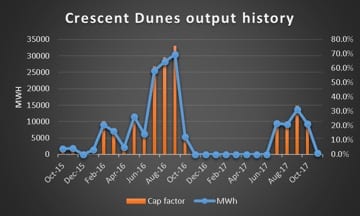On January 18, RenewEconomy reported that SolarReserve’s $650 million, 150MW concentrating solar thermal plant to be located near Port Augusta has been granted development approval.
We question whether the technology is sufficiently proven to justify building this project. If SolarReserve wants to use its own money, or that of a private sector bank, well good on them. Public money – the company is expected to get a $100 million grant from the federal government – is another thing.
SolarReserve’s flagship project is Crescent Dunes, a US$1 billion, 110MW first-of-its-kind project located, perhaps appropriately, near Las Vegas. Ground was broken in 2011 on the project.
The project has 10 hours molten salt storage but the relevant statistic is its design capacity factor of 51 per cent.
Not enough evidence that Crescent Dunes works
Production from the facility was first reported in October, 2015, and out of 26 months since then the facility has been completely offline for 9 months. On only 3 months has it met the annualized design goal.

SolarReserve management stated that the reason the facility was closed down for 8 consecutive months in 2016/2017 was a leak in the molten salt tank.
Leaving aside any questions of how that could happen, or why it should take 8 months to repair, we note that having started up again in July 2017 the facility did not reach design goal and as of November 2017, on the last data available, it appears to have virtually shut again.
It did not meet its design goal in any month after being restarted.
Leaving aside any questions of project economics we would simply say there is not enough positive evidence to suggest the technology works to the extent advertised.
As far as I am concerned I don’t really care what the company’s explanation of the problems are. If you want to put $100s of millions into a new technology you need enough evidence it works.
The only satisfactory evidence it works is production history of consistently meeting the design goal.
I’d note that there are at least three pumped hydro projects under development in South Australia, one of which Goats Hill, owned by Altura/Delta is only 12 km from Port Augusta with 8 hours storage and 220MW of power.
As I understand it Goats Hill is expected to receive development approval by mid 2018.
Given the evidence available from Crescent Dunes, my personal opinion is that Port Augusta should be put on hold until Cresent Dunes has shown it can operate at something like design capacity for at least 12 consecutive months.
David Leitch is principal of ITK. He was formerly a Utility Analyst for leading investment banks over the past 30 years. The views expressed are his own. Please note our new section, Energy Markets, which will include analysis from Leitch on the energy markets and broader energy issues. And also note our live generation widget, and the APVI solar contribution.









